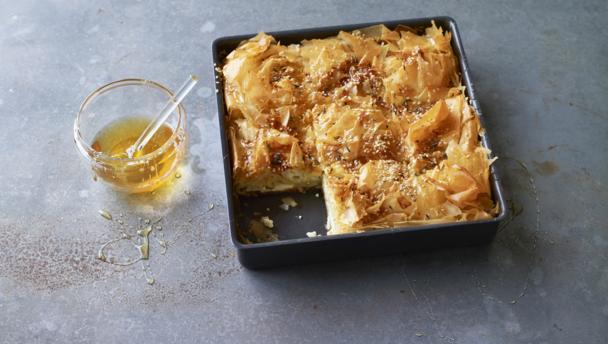
You need JavaScript to view this clip.
Preparation time
30 mins to 1 hour
Cooking time
30 mins to 1 hour
Serves
Makes 9 generous slabs
Recommended by
1 person
Dietary
Old Rag Pie is not the most glamorous name for something which, while being incredibly simple to make, will have you, and anyone who eats it, in raptures. The name is the English translation for the Greek Patsavouropita, created by bakeries as a way of using up old scraps of filo pastry: the "old rags" indicated by the title.
In Greece, there are two variants, one sweet, one savoury, but this version merges the two, adding honey to salty feta, to create what I can best describe (in taste terms) as a Greek cheesecake.

Melt the butter in a small saucepan, then take it off the heat.
Line a 20cm/8in square cake tin with a layer of filo, making sure it comes up the sides; you will need to use more than one sheet. Then pour 1 tablespoon of melted butter over the pastry.
Using one third of the remaining filo sheets, tear and scrunch the sheets up and drop them loosely in the tin. Then crumble in half the feta, sprinkle with 1 teaspoon of Parmesan and just under ½ teaspoon of thyme leaves (or ¼ teaspoon of dried thyme) and pour a third of the remaining melted butter over the top.
Repeat, so that you use up all but a little of the butter and a small amount of thyme. For the last layer, you can use larger pieces of filo “rags” (as it’s the lid), filling the tin a little more tightly, but still scrunching them.
Fold the edges of overhanging filo over themselves, and pour the remaining butter on top. Using the sharp point of a knife, make 2 cuts down and 2 cuts across into the filo-packed tin, from edge to edge to create 9 sections. It’s important that you don’t use a blunt knife, as you don’t want to drag the filo or press down on it.
Beat the eggs with the milk, then pour over the contents of the tin. Sprinkle the last bit of thyme along with the sesame seeds on top. Let it stand for at least 30 minutes in a cool place before baking. If 2 hours is easier for your timetable, then put it in the fridge. And you can do this in advance (see top recipe tips).
Heat the oven to 200C/180C Fan/Gas 6, and bake the pie for 30 minutes. When it’s ready, the pastry will be golden-brown and puffed up, and the inside set. Let it stand for 10 minutes, then spoon 1 tablespoon of the honey over the top.
Cut into slices or slabs – using a serrated bread knife and sawing action to prevent squishing the filo on top too much, then pushing the knife down to cut through. Serve the pie directly from the tin and put the jar of honey, with a spoon in it (or you can pour it into a jug) on the table for people to add extra as they eat.
I have made this with a variety of filo pastries, and I have found that the more widely available brands are too damp and too heavily sprinkled with flour to do the job well. Luckily, those brands make a frozen filo, which doesn’t seem to suffer from the same problems, which is why I stipulate this, below. (The other benefit of using frozen filo is that – given that feta has such a long shelf life – you can keep all the ingredients to make this in your freezer, fridge and storecupboard without an extra visit to the shops.) However, should you be lucky enough to have access to good quality, authentic filo, then please use fresh.
If you plan to freeze the pie before baking it, then you will definitely have to start with fresh, not frozen filo. Since the packets of frozen filo come in 270g/9½oz weights, that is what I have used, but another 75–100g/2½-3½oz or so wouldn’t go amiss. So, if you can buy this in bigger packets, or are buying fresh by weight, go ahead, but don’t break open a second packet for it.
You don’t need to worry about keeping your filo covered as you go, as is normally advised. It doesn’t matter if it dries out a little as you make it, indeed this can even be desirable.

By Henry Dimbleby
See more feta cheese recipes (100)

Simply Nigella
3. Simply Nigella
BBC Two
Recipes from this episode